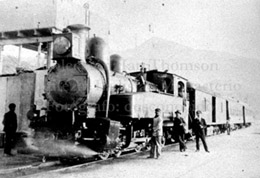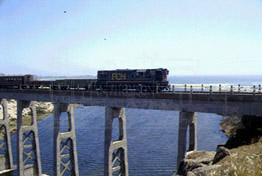ORIGINS OF LONGITUDINAL LINE AND PASSENGER TRAINS
The most ancient section of the longitudinal line is located between Toledo and Copiapó, which is part of the late pioneer Ferro-Carril Copiapó. Other segments also initially belonged to different private railways. These had a transversal (east-west bound) geographical orientation rather than longitudinal. For this reason, back when it was built only a few people considered this connection convenient. Because there were different players, the railway was built using different gauge trails: 1435 mmm for Ferrocarril de Copiapó and 1676 mm for Ferrocarril de Coquimbo. (Some dare to dream track connection from here to Valparaíso).
Immediately after the end of the Pacific War, the successive governments were strategically interested in connecting the central zone of the country with Northern Chile by a means of transportation other than maritime. National Treasury received large sums of money from nitrate export duties, but for a couple of decades, the focus was on discussing and conducting studies rather than investing in construction work. This changed in 1908 as Congress passed Law 2081 that authorized the Government to bid out the construction and subsequent operations for a longitudinal railway in the North. [See references (i) and (ix).]
From that moment on, lost downtime in earlier decades was quickly recovered, and at the end of 1913, there was a railway (rather say a group of railways) that ran from Pisagua in the North to La Calera station, from Valparaiso to Santiago, and from La Calera to Puerto Montt down south using 1 676 mm gauge width.
Operations had multiple complexities. For instance, North of La Calera, tracks were initially very uneven, and operations encountered different administrations which were responsible for different sections. In 1913 any brave person who decided to travel by railway from La Calera to the North of Chile, would have traveled to Cabildo on a metric gauge railway, operated by EFE. From Cabildo to Limahuida, the trail remained metric, but the operation would switch to Sindicato Howard, who had the rights over the concession for the section. From Limahuida to Illapel operations would reverse to EFE, and Sindicato Howard would then take control for the next leg of the trip up to San Marcos. In San Marcos, EFE assumed responsibility again, on a 1 676 mm gauge track up to Islon, where the passenger had to experience yet another change back onto metric gauge railway, operated by the Sindicato Howard. This last trip ended in Toledo, where the passenger travelled on an EFE operated train for the final stage taking him to Pueblo Hundido. [See reference (iii).]
Sindicato Howard had previously built missing sections of the longitudinal line between La Calera and Pueblo Hundido, while the metric gauge section North of this town (currently known as Diego de Almagro) was built by Chilian Northern Railway Co. Ltd., taking responsibility for the operations up to Pintados. At Pintados, the Chilian Northern routes and the Nitrate Railways merged their 1 435 mm gauge tracks and followed through to Iquique and Pisagua. In conclusion, it was possible to travel by train from Puerto Montt to Pisagua, but travel north of La Calera was reserved for the more audacious.
The above translated into highly difficult operations situation that had to be addressed. In addition to this, the concessionaries – Sindicato Howard and Chilian Northern - did not foresee any possibility for profitable exploitation. Fortunately, by the end of the same decade, the operation had regained some level of comfort, to some extent, since the leg from La Calera to Pueblo Hundido was wholly managed by EFE. All tracks were switched metric gauge and the section was named "Northern- Central Network", which was later shortened to "Northern Network". Although the Northern Network operation was simpler than its antecessor, the word "simple" was not the most appropriate yet. There remained some sections where the trains had to be towed on rack-and-pinion railways. Between La Serena and La Calera there were two points where it was necessary to unhook the regular locomotive from each train and replace it with a rack-and-pinion one for the next section. [See reference (i).]
The railway North of Pueblo Hundido remained controlled by the Chilian Northern, but this was now controlled by the Ferrocarril de Antofagasta a Bolivia (FCAB). [See reference (18th).] The metric gauge ran from La Calera to Pintados. From that point North the tracks had 1 435 mm gauge, forcing a change of crew at Pintados Station.
Travel by train was no longer exclusively for adventurers, but was not recommended for those lacking patience. People who boarded the train departing from La Calera at 22:30hrs on Saturday, would arrive at Pueblo Hundido at 16:50hrs on Monday, where there would be a 25 minutes layover, arriving at Pintados at 03.20hrs on Wednesday. This, evidently, provided there were no delays. Then they would have to transfer to a different train, which would arrive at Iquique at 10:30hrs that same day. The train travelled at an average speed of roughly 22 km/hr.
Some of the mentioned complications were solved starting in 1928. The opening of the metric gauge Ferrocarril de Iquique a Pintados bypassed the prior need to change from a 1 435 mm gauge train, hence saving time and comfort. During the next 16 years, another difficulty was surpassed as all rack-and-pinion railways were replaced. Despite the progress, by 1953, travel by train between La Calera and Iquique was not recommended for impatient people. Even with a single rail gauge and diesel traction to south Pueblo Hundido, the average speed did not exceed 28 km/hr.
In 1975, the last passenger trains between Iquique and La Calera ran, and shortly after trains running from La Calera to La Serena also ceased operations. In 1975, moments away from fully closing operations and with locomotives running solely on diesel traction, trains achieved a speed of 33½ km/hr. Since 1978 the network, now owned by Ferronor, has been exclusively utilized for freight trains.
| Table 5: THE BRANCHES OF NORTHERN NETWORK (AFTER REMOVAL OF RACK-AND-PINION TRACKS) |
| DEPARTURE |
ARRIBAL |
KMS. |
TRAINS PER WEEK AND DIRECTION, 1946* |
Rayado
|
Papudo
|
27
|
6 |
| (Placilla) |
Trapiche |
18 |
0 |
| Rayado |
Petorca |
57 |
10 |
| Limahuida |
Salamanca |
24 |
5 |
| Paloma |
Juntas |
18 |
5 |
| Puntilla |
Tamaya |
35 |
0.115 |
| Islón |
Rivadavia |
74 |
13.5 |
| Vallenar |
Huasco |
50 |
12 |
| Toledo |
Caldera |
72 |
9 |
| Paipote |
Tres Puentes |
49 |
2 |
| Pueblo Hundido |
Chañaral |
63 |
5 |
| Notes: * charter trains shown as 0.5 x scheduled train; trains covering a part of the branch were prorated. All trains carried passengers, many had mixed operations (passengers + cargo). There were no scheduled cargo trains running on any of the branches. |
| Source: Maestranza de Ferrocarril Regional del Norte de Chile, Coquimbo. |






